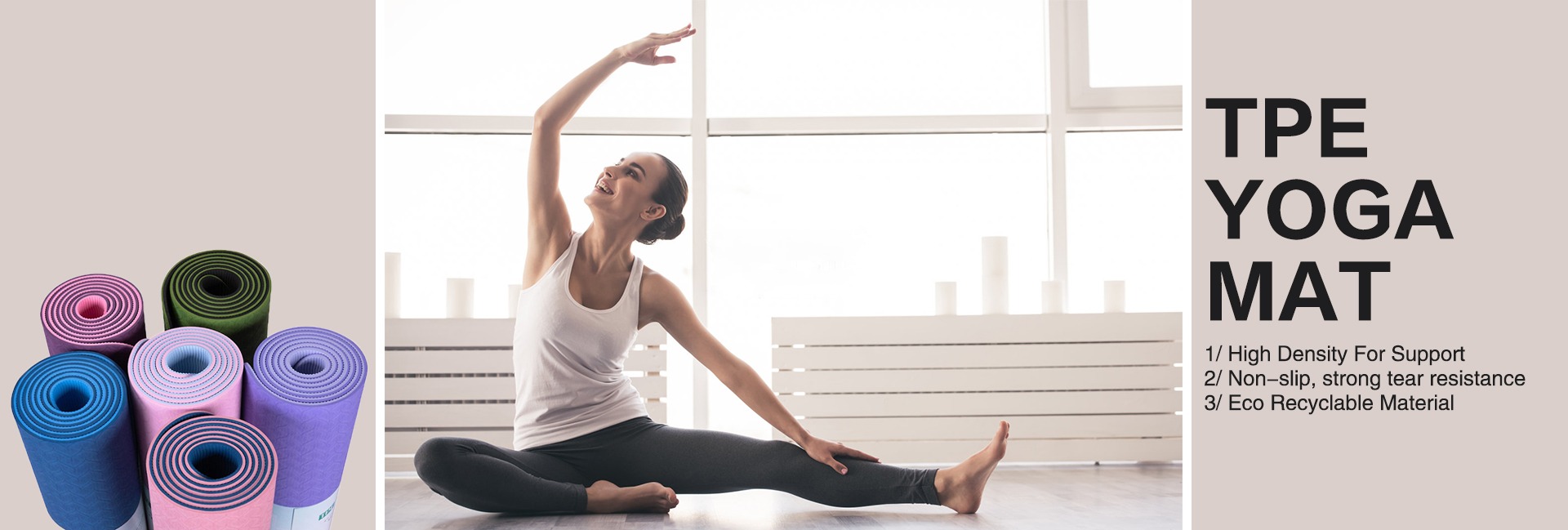If you’re just starting on your yoga journey, it may be that you’ve only ever used a mat at your studio. However, if you prefer to practice your yoga at home or feel that you need your own yoga equipment especially in light of Covid-19 considerations, you need to choose your mat carefully. There are so many different options out there from natural rubber yoga mats to cheaper TPE yoga mats that it can be a little confusing to work out which would be best for you. But, don’t worry, as a yoga mat manufacturer of yoga mats,we’re here to help you out.
Thickness and Weight
One of the first things to consider is the thickness and weight of your mat.The thickness of your yoga mat has a lot to do with how comfortable it is.If it's too thin,your knee may get banged up during crescent lunge.If it's too thicker,make it hard for you to find balance in standing postures, like Tree Pose.Our general thickness is 4mm and 5mm and weight around 3kgs to 3.5kgs.
On the other hand,Considered easier to carry in a bag.Our 1.5mm suede yoga mats is extremely thin and lightweight,the weight around 2kgs.So that they can be easily carried about as travel yoga mats.-It's a better choice when you're traveling.
Composition and Durability
A thicker yoga mat will last longer than its thinner counterpart, however longevity also comes down to the type of material, the material your yoga mat is made of dictates its texture, stickiness, ecofriendly, and sponginess (how much it yields to pressure)and how it wears over time.
Many cheaper yoga mats are made of PVC, which is not the most eco-friendly option. PVC yoga mats is not biodegradable, which means the mat might last a bit longer, but it’s not environmentally friendly.
TPE yoga mats is made of plastic with thermic and elastic properties.It’s a polymer yoga mats,it’s less polluting than PVC.Which makes it a better alternative to PVC.TPE is easily moulded,extruded and reused.TPE yoga mat material is popular because of its low weight and long life.However,the downside of TPE yoga mat material it’s not easily recyclable and degrades slowly in a landfill.When you first use new TPE yoga mat,it has a strong plastic smell.
If you really want to contribute to the environment meanwhile you also want a high quality yoga mat,Natural rubber is also good choice for you.Natural rubber is made from the sap of rubber trees found in South America (Brazil) and South Asia (Malaysia, India, Thailand, and Indonesia).Natural rubber is harvested from trees by making incisions in the bark and collecting the milky fluid. Different items can be made from natural rubber,such as PU natural rubber yoga mats,suede natural rubber yoga mats and cork natural rubber yoga mats.Natural rubber yoga mats are impermeable, have a good grip and are washable.It’s one of the best options for a yoga mat.
Texture
Another important consideration is whether you opt for a smooth or textured mat. Smooth mats tend to be more ‘sticky’, and are ideally suited to a more athletic yoga practice, particularly Vinyasa, when you have to make quick transitions or trust your whole body weight to your hands and feet – or even just your hands!A smooth surface will help with powerful movements and flowing from one pose to another. However, avoid PVC mats as they are just too slippery – choose a mat made from natural rubber instead. Mats with a textured surface offer more grip and are commonly used for gentler yoga poses such as those found in Hatha, Yin and Iyengar. Textured rubber mats are a great option, or you may want to try a jute or cotton yoga mat.
Where Will You Practice?
Are you planning a home and studio yoga practice? If so, you won’t need to consider the weight of the mat. As a beginner to Yin or Hatha yoga, a heavier, sturdier 5mm mat will give you the cushioning you need. If you’re planning to join in classes on outside, a lightweight 1.5mm yoga mat with bag is the best choice, but make sure it’s long enough to fit your mat comfortably.
Price range
Typically, a basic 1/8 inch thick, plain solid-color PVC and TPE yoga mat will be toward the low end of the price range.Eco-friendly natural rubber yoga mats tend to be toward the high end of the price range.You also can spend extra cost to custom logo or colorful pattern design on yoga mats.General,we will custom logo or alignment line on TPE,PU and cork yoga mats via laser engraved.We also can custom colorful pattern design on suede and cork yoga mats via heat transfer printing.
STYLE
Once you've narrowed your choices down by thickness, material, texture, weight,eco-friendliness, and price, there's only one factor left: style! So go ahead and pick your favorite color, pattern, or print. After all, you'll be seeing a lot of it in downward dog. Happy shopping!
Take all you've learned, Welcome to inquiry all yoga mats form bsmyogamats.com~~~
If you want to know more details about different natural rubber yoga mats and how to maintain the yoga mats,please wait my next article.
Natural Rubber PU Yoga Mats:https://www.bsmyogamatss.com/pu-yoga-mat_c11
Natural Rubber CORK Yoga Mats:https://www.bsmyogamatss.com/cork-yoga-mat_c12
Natural Rubber SUEDE Yoga Mats:https://www.bsmyogamatss.com/suede-yoga-mat_c10
Eco-friendly TPE Yoga Mats:https://www.bsmyogamatss.com/tpe-yoga-mat_c17

 온라인 서비스
온라인 서비스 0086 187 2606 2816
0086 187 2606 2816 Info@secondpagetech.com
Info@secondpagetech.com 0086 181 5606 3146
0086 181 5606 3146